Posts Tagged ‘630m’
 ARRL 160 / 630m DX
ARRL 160 / 630m DX
 |
| courtesy: http://www.arrl.org/ |
This weekend's ARRL 160m CW was a ton of fun.
Conditions were unusually good, which always makes things more interesting.
I ended up with 412 contacts in 78 out of 83 ARRL sections. If I was attempting a WAS on Topband, I would have made it to 48, missing just Nebraska and Rhode Island. Oddly enough, RI was my 50th state when I completed my original 160m WAS, back in 1984, which was certificate #225.
That was done from my tiny 33' wide suburban lot, using the same antenna that I have now, a half-sloper. My radials were strung around all four edges of the property line and just lay on the ground or were stapled to the fenceposts. The power came from a pair of 6146's and was just a little less than I used in the contest this weekend as I entered in the Low Power (150W) category ... however, back then it took me several winters to finish my Topband WAS as there was a lot less activity than there is nowadays it seems. The only other sections missed during the contest were Puerto Rico, Newfoundland and North New York.
With a fairly dormant Sun and the 'almost-quiet' geomagnetic conditions of late, good propagation continued into the week ... in fact, Sunday night was the best I have ever observed on 630m!
Such stable conditions here on the west coast always favor the east-west and polar paths and Sunday proved that in spades. Overall, 53 different stations reported reception of my 630m signal, more than any previous overnight period.
The highlight however, was the reception of my signal in Europe, with five decodes from LA2XPA on Kalvoya Island off the southwest coast of Norway. Rolf has an exceptional location and nice beverage antennas so most of the heavy-lifting was being done on his end. However, without the co-operation of the propagation gods, none of this would be possible. To make things even better, John, VE7BDQ, also made it across to Norway as his small station continues to perform amazingly well. As I mentioned in an e-mail earlier today, his is the textbook example of what can be done on 630m with a small suburban backyard, some homebrewing skills and a small antenna system.
 |
| courtesy: http://wsprnet.org/drupal/wsprnet/map |
The WSPRnet map shown here illustrates just how many folks are tuning in every night to this part of the spectrum ... with many getting instantly hooked. Hopefully this great propagation is just a small taste of what lies ahead for us over the next several years of low solar activity.
 Saturday’s 630m Crossband Night – Reminder
Saturday’s 630m Crossband Night – Reminder
This is a reminder of tomorrow's '630m activity night'. Highlights of the evening will see six different Canadian stations seeking contacts with other amateurs in North America via the 'crossband mode' as they call CQ on 630m CW but listen for replies on their announced (QSX) HF frequency. As well, there will be an increased level of on-air activity from many of the U.S. experimental stations, as they beacon or work each other on various modes including CW and JT9, the WSPR QSO-mode. The experimental stations are also seeking your reception reports.
More information may be found here regarding the activity night, including a detailed list of participating Canadians along with their respective transmitting and QSX HF listening frequencies.
As is often the case, old 'Sol is threatening to throw some junk our way over the next day or two, right on time for our event but please don't let that stop you from participating as often this can actually enhance propagation, especially on the north-south path.
We hope to see many of you tomorrow night!
 November’s 630m Activity / CW Crossband Night!
November’s 630m Activity / CW Crossband Night!

Once again the 630m band will become a cacophony of CW and other sounds on Saturday night, November 12th! The actual motivation for the weekend event is a celebration of the November, 1906, Berlin Treaty ... making 500 kHz the International Distress Frequency for the next eighty years. It's also a great excuse for a lot of 630m diehards to get on the air and celebrate the band.
Three different groups will participate:
U.S. Experimental Operators
Canadian Amateurs
Maritime Radio Historical Society
U.S. Part-5 Experimental Operators including WD2XSH stations and others will operate in the 472 – 479 kHz band. They will use CW transmissions for QSOs and beacons with special messages. There may also be some operation on 500 kHz itself.
Canadian Amateurs will be concentrating their efforts on providing two-way cross-band CW QSO's with other amateurs in the U.S.A. and Canada. They will be transmitting on specified frequencies (see below) and listening for replies to their 'CQ' on specified QSX frequencies within the 160, 80 and 40m CW bands.
The Maritime Radio Historical Society will activate its KSM/KPH transmitter at Bolinas, CA for a mini “Night of Nights” with special messages and bulletins.
Listeners are encouraged to send their reception reports to individual stations or via the LF/MF ON4KST chat page which should be very active during the event. Most experimental calls can be found via QRZ.com listings.
All amateurs are encouraged to participate in the cross-band activity by being able to listen on 630m but being able to answer on one of the specified HF bands.
So far this fall, propagation on the 630m band has been excellent and hopefully will continue well into November. Previous cross-band events have seen contacts made from coast-to-coast as well as west to Hawaii.
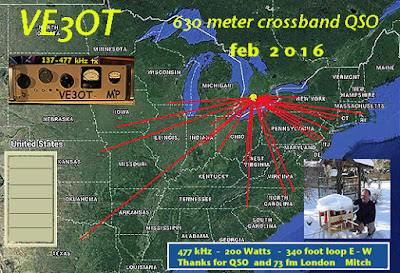 |
| VE3OT QSL and coverage from previous crossband event |
Confirmed Canadian stations include:
Station: VA7MM (Mark) CN89 Coquitlam, B.C.
Time: 0400Z – 0800Z (Saturday night Nov 13 Z)
TX Frequency: 475.0 kHz
RX (QSX) Frequency: 1801 kHz / 3574 kHz / 7062 kHz
Station: VE7BDQ (John) CN89 Delta, B.C. November 2016
Time: 0300Z – 0700Z (Saturday night Nov 13 Z)
TX Frequency: 474.0 kHz
RX (QSX) Frequency: 3555 kHz
Station: VE7CNF (Toby) CN89 Burnaby, B.C.
Time: 0300Z – 0800Z (Saturday night Nov 13 Z)
TX Frequency: 476.5 kHz
RX (QSX) Frequency: 1836 kHz / 3558 kHz / 7031 kHz
Station: VE7SL (Steve) CN88 Mayne Island, B.C.
Time: 0200Z – 0700Z (Saturday night Nov 13 Z)
TX Frequency: 473.0 kHz
RX (QSX) Frequency: 3566 / 7066 kHz
Station: VE7CA (Markus) CN89 North Vancouver, B.C.
Time: 0200Z – 0700Z (Saturday night Nov 13 Z)
TX Frequency: 477.5.0 kHz
RX (QSX) Frequency: 1820 / 3550 / 7048 kHz
Station: VO1NA (Joe) GN37 Torbay, Newfoundland
Time: 2130Z – 0130Z (Saturday night Nov 12 Z – Sunday Nov 13 Z)
TX Frequency: 477.7 kHz
RX (QSX) Frequency: 3562 kHz
Station: VE3OT (Mitch) EN92 London, ON.
Time: 0000Z – 0400Z (Saturday night Nov 13 Z)
TX Frequency: 477.0 kHz
RX (QSX) Frequency: 3563 kHz / 7058 kHz
Several US Experimental stations also will be in operation throughout the band, in two-way QSO mode with each other, using CW or JT9. Some stations will also use WSPR and QRSS CW beacon modes.
The success of this event largely depends upon the participation of as many amateurs as possible.
Hopefully you will be able to participate in the two-way cross-band activity by being able to listen on 630m and then able to switch over to HF to transmit. This could involve the use of a separate receiver / transmitter or can often be easily implemented via your transceiver's 'A/B' switch.
No antenna for receiving on 630m? Don't let that stop you from taking part in the fun. Surprisingly good results can often be had by using a low band wire antenna such as a dipole or inverted-L for listening on 630m ... the antenna does not necessarily need to be resonant. In fact, often times, a non-resonant receiving antenna can provide a better overall S/N ratio than one which is resonant, as these often gather more noise along with signals.
You may want to experiment before hand by listening to many of the numerous U.S. experimental stations operating nightly, mostly in the WSPR mode, between 475.6 and 475.8kHz. Most operators provide a CW identifier following their WSPR transmission but a better way to decode these signals is by installing the latest WSPR software, WSJT-X (freeware), at K1JT's website here. The software works extremely well and is easy to install and get working. If you set the software to 'upload spots', you can share your nightly catches with dozens of other listeners throughout the continent on the WSPRnet website.
 |
| courtesy: KB5NJD's 630m Daily Blog |
If you have further questions, please contact myself or John Langridge, KB5NJD / WG2XIQ.
 630m VK’s Light-Up North America
630m VK’s Light-Up North America
It seems that all of my blogspots of late have focused on 630m propagation ... but what has been happening down there recently has been both amazing and somewhat unexpected. With the growing number of active stations listening and transmitting, the band's propagation capabilities and mysteries are quickly revealing themselves.
Last night was a great example but perhaps the WSPRnet prop map illustrates this best.
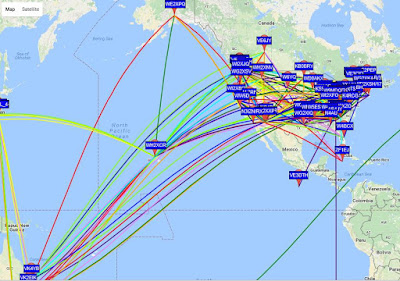 |
| courtesy: http://wsprnet.org/drupal/wsprnet/map |
Particularly striking was the long haul propagation from VK to North America, with northernmost VK4YB leading the pack. His 90 watt signal made it all the way to VE3IQB, near Ottawa as well as to NO3M, in Pennsylvania! To provide further hope to those that have little room for big receiving antennas, VE3IQB uses a typical small active e-probe antenna, 20' above ground!
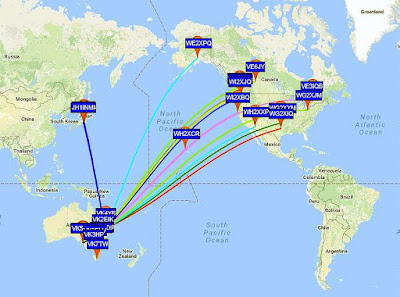 |
| courtesy: http://wsprnet.org/drupal/wsprnet/map |
 |
| courtesy: http://www.swpc.noaa.gov/ |
I'm theorizing that Roger's signal was arriving today at much lower angles than normal, evidenced by its far-reaching east coast reception and the fact that it couldn't get over my 600' local obstruction to the west. I've always believed that it takes higher angled signal arrival for me to hear Roger and today's events seem to support this.
Exactly what would cause this to be the case, I'll leave to the experts but I imagine that the sudden surge in geomagnetic activity played a significant role in today's very different propagation paths.
Roger was not the only VK lighting-up the map today. A much more detailed account of all the action can be found on the KB5NJD's daily 630m report here ... all very inspirational and hopefully enough to spur even more new activity on the MF band.
Why not give a listen and see what you can hear?
 VE3 – VE7 630m QSO
VE3 – VE7 630m QSO
The 630m band continues to provide interesting challenges for Canadian amateurs ... be they antenna, equipment or propagation related.
Sunday night produced another flurry of excitement on the new band, further demonstrating its potential for small stations operating from the suburbs.
On Sunday evening, VE3CIQ in Carleton Place, Ontario (southwest of Ottawa), and I, completed a two-way JT9 contact, following a short exchange of the required information (and more) just after midnight, Ontario time.
 |
| courtesy: https://www.google.ca/maps/ |
Noting the increased east-west favorability over the past few nights, Phil and I decided to give it a shot and were delighted to cover the 2200 mile / 3500km path while Murphy was sleeping and not messing with propagation.
Rather than randomly beacon on JT9, we both set 'calling each other' messages. Although this continued for some time, the QSO only took 12 minutes to complete once I started to decode Phil's signal out west. He had been decoding me and sending signal reports for a long time before his signal eventually peaked up here for the evening. I suspect that we could have continued the contact for the remainder of the night as his signal was getting stronger and stronger as we worked.
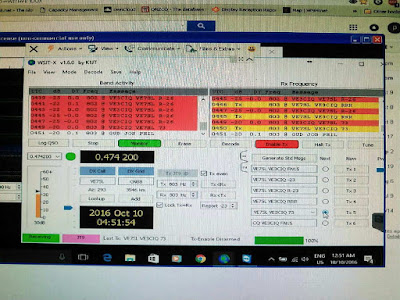 |
| Screen shot of QSO from VE3CIQ's end |
| VE3CIQ - 630m Station |
| VE3CIQ - Homebrew 630m Class-E Transmitter |
| VE3CIQ - 630m Linear-loaded Antenna |
Phil's station stands as yet another fine example of those living in the suburbs without a lot of room for antennas yet still able to successfully operate and explore our new 630m band. With a little ham-radio creativity, it's surprising how well a small station can perform, especially when the propagation co-operates.
Following our contact, I moved back to the WSPR section of the band and continued beaconing overnight.
Apparently Phil and I picked a good evening to run a sked as the overnight WSPR map shows it to have been the best night of the new DX season so far, with forty-four individual stations reporting my signal via the WSPRnet website.
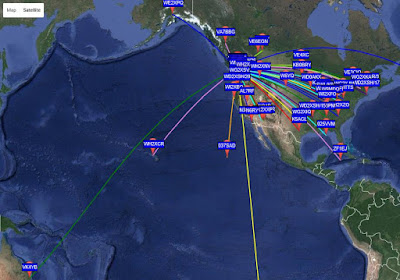 |
| courtesy: http://wsprnet.org/drupal/ |
 The GØMRF Class-D 630m Transmitter
The GØMRF Class-D 630m Transmitter
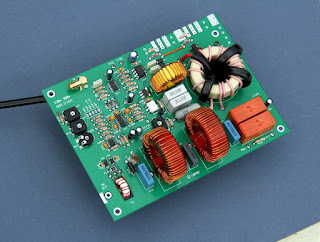 |
| courtesy: www.g0mrf.com/ |
Dave, GØRMF, long time LF proponent and ardent home-brewer has recently posted construction details of his new 630m transmitter.
It is a readily reproducible design that may be of interest to those looking for a transmitter capable of developing full ERP power output.
From Dave's description:
This amplifier is based on the ‘300W Class D Transmitter for 136kHz’ published by the RSGB in Radio Communication and reproduced in the LF Experimenters Handbook by Peter Dodd G3LDO.
This circuit, updated and modified for 630m, uses 2 MOSFETs in push pull driven by square-waves from a CMOS D-type flip flop. The power can be varied from around 25 to 300W by increasing the supply voltage over a 12 to 32V range. Circuits are included to protect against excessive supply current and high reflected RF power.
The amplifier is suitable for any non-linear mode. Examples include CW, QRSS, WSPR, JT-9, JT-65 and FSK.
The circuit has been built on a dedicated double-sided PCB measuring 164 x 120mm. For ease of construction 90% of the components are leaded but it has been necessary to use a few surface mount devices as the normal DIP versions of some ICs are increasingly difficult to find.
In many respects, this circuit is similar to my own homebrew transmitter which can be used on both 630 and 2200m. Although Dave has built his circuit on double-sided PCB, the project would be equally at home on one-sided board or even constructed 'Manhattan' style, the method I chose. This latter style lends itself to easy component swapping to optimize circuit performance.
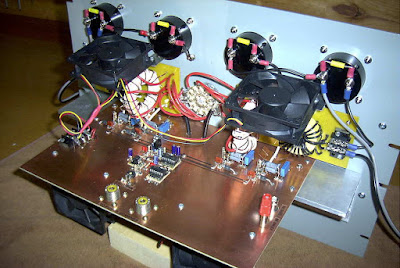 |
| VE7SL 2200m / 630m Manhattan-style Transmitter |
In addition, Dave's website contains several interesting circuits that might be of interest to those getting started on 630m.
 VK-VE 630m Repeat
VK-VE 630m Repeat
On Saturday morning, VK4YB and I had our second QSO on 630m using JT9, the WSPR QSO mode. Signals were slightly better than our initial contact but still far from previously seen conditions on the 11,000 + km Trans-Pacific path. However what happened following our contact was equally exciting.
I thanked Roger for the contact, via the ON4KST LF / MF chat page and indicated I was going back to bed as it was still pre-sunrise here on the west coast. He indicated that my signal strength had increased noticeably on my last two transmissions and asked if we might try CW for a few minutes.
We had previously devised our CW protocol to follow a similar one to that used in CW moonbounce work. We would transmit and receive in one minute sequences, with me transmitting on the even minutes and Roger on the odd. Instead of using the RST code for signal reporting, an 'O' is used to indicate reception strong enough to have been able to copy both calls. Both stations are required to copy the 'O', which cannot be sent until both calls have been fully copied. An acknowledgement ('R') must also be sent and copied by both stations to indicate receipt of the signal report. Once the 'R' has been copied, the final transmission(s) are a '73'. Once both stations have copied the 'R', the '73' is technically not required but when copied, further confirms the completion of a valid contact.
For both of us (late at night for him and pre-dawn for me), it was a bit of a mad scramble to make a quick changeover to CW. From my end, there are a number of changes that must be made correctly to avoid over-driving the transverter and damaging the frequency doubler as well as changing to manual PTT to avoid hot-switching of the antenna relays. I also need to bring up the PC's visible clock-face with its sweep second-hand ... but we both made the transition in about two minutes.
We ran for about 45 minutes during which time I heard Roger's CW on two back-to-back sequences (1331Z and 1333Z), copying both calls on each sequence. From 1331Z on, I added Roger's signal report to my calls to him ... 'VK4YB VE7SL OOO'.
We stopped at my sunrise but Roger had only copied fragments of my transmission and never enough to copy both calls. It appeared that we could both have used a few more db on the path as previous estimates have indicated that we might see at least another 5 or 6db yet, on a really good morning. As well, it seemed that the TP pipeline on Saturday morning had centered itself to my south, around northern California and VE7 was on the far northern edge of the propagation path.
Well it seemed that Sunday morning had moved the path further to the north and our 'extra 5-6db' was on hand. All of the local VE7's had numerous decodes of Roger's WSPR signals, including my own 20 decodes in the pre-dawn hours, but ... as 'Murphy' would have it, Roger was suffering receiver-blocking thunderstorm / lightning noise, keeping his K3's s-meter hard against the pin and absolutely no chance of a CW sked. It may have been a much more exciting morning had the spring weather near Roger been more cooperative.
This morning, the weather was still restricting good reception down-under but is forecast to dissipate shortly. But Murphy has not finished with us yet, as the TP path had also noticeably deteriorated today as well. It looks as though the challenge will now be getting everything to come into perfect alignment before the summer weather in VK shuts our CW attempts down for the season.














